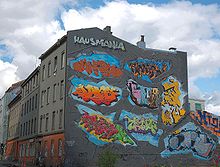Squatting in Norway is taking possession of land or an empty house without the permission of the owner. The first public occupation was Hjelmsgate 3 in 1969 and self-managed social centres which were first squatted and then legalized include the Blitz House, Hausmania and UFFA. Brakkebygrenda was a land squat which has twice been evicted.


History
editIn Oslo, the capital of Norway, the first public occupation was Hjelmsgate 3 in 1969. It was quickly legalized and became a base for anarchism and countercultural activities.[1] In the 1980s, buildings were occupied by a radical left-wing movement which had links to Denmark and Sweden.[2] Most famously, houses on Skippergata were squatted and then after eviction, the Blitz House was occupied at Pilestredet 30.[1][3] Blitz is a self-managed social centre which hosts radiOrakel (a feminist radio station), a bookshop, a music venue and a vegan café.[4]
Hausmania is a complex of buildings in Oslo that has been squatted from 1999 onwards. The cultural centre at Hausmannsgate 34 has a cinema, galleries, a vegan café and a theatre.[5] Hausmannsgate 34 was evicted in 2016 and 11 people were arrested.[6] Brakkebygrenda was also occupied in 1999. It was a land squat where people lived in caravans and motorhomes, which has been evicted twice.[1] The eviction in 2008 was resisted by between 30 and 40 squatters throwing projectiles, and a caravan was set on fire. In 2014, the site was evicted again in a large police operation, which closed nearby roads.[7][8] Property developers Urbanium, who bought property on the Hausmania site, were reported by Klassekampen to have been involved in the eviction of Brakkebygrenda.[9]
In Trondheim, the self-managed social centre UFFA was created in 1981. After the original building was burnt down, the centre moved to its present location. It houses a bookshop, a cafe, a concert space and offices for the anarchist newspaper Folk & Røvere.[10] Blitz, Hausmania and UFFA are all centres for anarchism in Norway.[11]
References
edit- ^ a b c "Okkupasjoner i Oslo 1970–2011" (PDF). Pollen. 1. 2011. Archived from the original (PDF) on 24 September 2021. Retrieved 12 February 2021.
- ^ Fahlenbrach, Kathrin; Sivertsen, Erling; Werenskjold, Rolf (February 2014). Media and Revolt: Strategies and Performances from the 1960s to the Present. Berghahn Books. pp. 368–379. ISBN 978-0-85745-999-2. Archived from the original on 5 February 2021. Retrieved 5 February 2021.
- ^ Hvidsten, Sigrid (3 November 2004). "Pønk og politikk". Dagbladet (in Norwegian). Retrieved 12 February 2021.
- ^ "Blitz – An Autonomous Youth House – Department of Criminology and Sociology of Law". www.jus.uio.no. Retrieved 12 February 2021.
- ^ Andersbakken, Ola. "Fra anarkisme til mainstream? Antropolog studerte kulturhuset Hausmania i Oslo". Antropologi. Retrieved 24 April 2019.
- ^ Bach, David; Helle, Birk Tjeldflaat; Johansen, Linn; Braaten, Magnus (6 July 2016). "Politiet kastet ut 14 okkupanter fra Oslo-bygård". VG (in Norwegian Bokmål). Retrieved 12 February 2021.
- ^ Meldalen, Sindre Granly (5 May 2008). "Kamp mellom politi og okkupanter i Oslo". Dagbladet (in Norwegian). Retrieved 12 February 2021.
- ^ Johansen, Kristoffer Egeberg, Anders Holth (4 June 2014). "Politiet til aksjon mot "Brakkebygrenda" i Oslo". Dagbladet (in Norwegian). Retrieved 12 February 2021.
{{cite news}}: CS1 maint: multiple names: authors list (link) - ^ Nilsen, Torbjørn Tumyr; Brække, Jonas (19 August 2015). "Tas over av utviklere". Klassekampen. Retrieved 12 February 2021.
- ^ Aas, Elisabeth (26 September 2011). "Nytt hus for UFFA om et år". NRK (in Norwegian Bokmål). Archived from the original on 5 February 2021. Retrieved 12 February 2021.
- ^ Kuhn, Gabriel (2009). "Anarchism, Norway". The International Encyclopedia of Revolution and Protest: 1–2. doi:10.1002/9781405198073.wbierp0067. ISBN 9781405198073.
Further reading
edit- Muri, Beate (27 April 2015). "'Brakkebygrender' mot bolignød". Dagsavisen (in Norwegian). Retrieved 8 March 2021.
- Nilsen, Torbjørn Tumyr; Brække, Jonas; Mohr, Anniken C. (19 August 2015). "Tas over av utviklere". Klassekampen. Retrieved 8 March 2021.